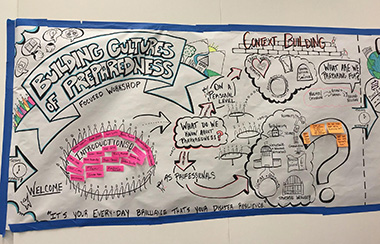CEHC Professors Help FEMA Build ‘Cultures of Preparedness’
.jpg) |
|
CEHC professor Eric Stern (pictured above) leads a presentation during the FEMA Higher Education Program's two-day workshop at Georgetown University. |
ALBANY, N.Y. (Feb. 12, 2019) – Eric Stern has long argued that collaboration between academics and practitioners is essential to improving our nation’s emergency management – a theory that earned him a front seat in helping to shape implementation of the Federal Emergency Management Agency’s (FEMA) new strategic plan.
Stern, a professor at the College of Emergency Preparedness, Homeland Security and Cybersecurity (CEHC), has co-authored a new FEMA report intended for the emergency management higher education community titled “Building Cultures of Preparedness.”
The 38-page report directly aligns with FEMA’s 2018 strategic plan – which will guide the federal agency through 2022. Among the plan’s three overarching goals is to build cultures of preparedness from the “bottom up,” embracing the idea that local communities and government can and should support national efforts when disaster strikes. In the year prior to the plan’s release, there were 16 weather and climate events in the U.S. alone, which result in 362 deaths and came at a record-breaking cost of $306 billion.
FEMA notes in the plan: “The most effective form of emergency management is one in which every member of the community understands his or her important and indispensable role. The ability of the nation be truly ready depends on everyone knowing and understanding the part they play in our collective resilience.”
Stern was among a small group of disaster management experts and anthropologists that were invited to work with FEMA Higher Education Program Manager Wendy Walsh to develop a report that would support the agency’s new strategic plan and vision.
The report was published last month and shared with educators across the country, along with emergency managers, communities and municipalities, researchers, students, practitioners, funders and other interested parties. Its lead authors are Katherine Browne of Colorado State University and Laura Olson of Georgetown University who are both part of the Culture and Disaster Action Network (CADAN).
“One of the big messages here is that preparedness means different things to different people,” Stern said. “We need to look at where people are coming from culturally. What does preparedness mean to them? How do we build on their strengths, recognize vulnerabilities, and incorporate their communities into the bigger picture?”
“The idea for this report is to bring academics into the conversation. Colleges and universities need to work on their own culture of preparedness. They also offer a wealth of knowledge through research and innovation on campus and established community partnerships,” he continued.
 |
|
Georgetown University Workshop participants visualized their thoughts for building cultures of preparedness on a "harvest of ideas" wall.
|
Higher Education Workshop
In May, FEMA’s Higher Education Program organized a two-day workshop at Georgetown University. It brought together 39 disaster scholars and subject matter experts from around the country to share viewpoints about how our nation can support the agency’s priority of building cultures of preparedness.
The group’s thoughts were recorded graphically through a “harvest of ideas” wall as well as through traditional notes, photography and poetry.
Stern attended the workshop – along with CEHC assistant professors Amber Silver and Samantha Penta.
“I really believe strongly in the connection between research and practice,” said Penta. “This was a collaborative workshop, which when you think about it, is really what building cultures of preparedness is all about. We need to work together to bring about important changes in our field.”
“For most people, preparing for disaster is not something you think about, until you have to. We are working together to switch that mindset,” added Silver. “Preparedness needs to be proactive, instead of reactive.”
Stern co-wrote a chapter in the “Handbook of Disaster Research” last March that identifies a number of ways that researchers and practitioners can engage in sharing useful and usable knowledge about disasters and emergencies.
You can read more about that chapter in the UAlbany NewsCenter.
![]() For more news, subscribe to UAlbany's RSS headline feeds
For more news, subscribe to UAlbany's RSS headline feeds
A comprehensive public research university, the University at Albany-SUNY offers more than 120 undergraduate majors and minors and 125 master's, doctoral and graduate certificate programs. UAlbany is a leader among all New York State colleges and universities in such diverse fields as atmospheric and environmental sciences, business, education, public health,health sciences, criminal justice, emergency preparedness, engineering and applied sciences, informatics, public administration, social welfare and sociology, taught by an extensive roster of faculty experts. It also offers expanded academic and research opportunities for students through an affiliation with Albany Law School. With a curriculum enhanced by 600 study-abroad opportunities, UAlbany launches great careers.


